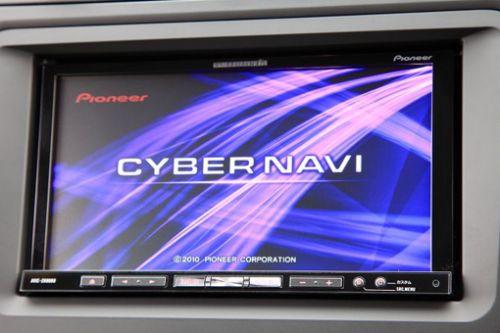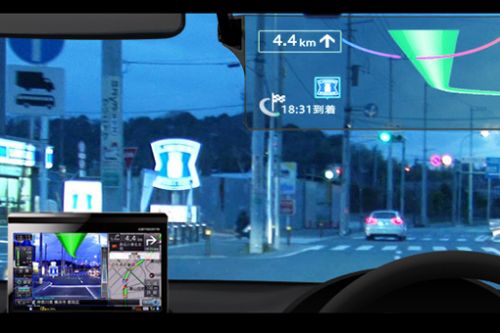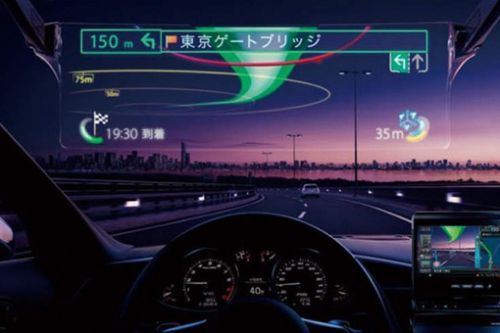The “Cyber ​​Navi†of the Carrozzeria series of car navigation systems was launched in Japan in July last year. This product is very convenient for users who have poor eyesight and can hardly see the screen information of the car navigation system, and can actually feel like a science fiction movie. The Cyber ​​Navi principle is simpler than you think: Just remove the driver's sun visor and set up a head-up display (HUD) on the mounting hole. Then use the laser to project the navigation information onto a plastic combiner that looks like a goggle. The combiner will be like a magnifying glass. It will display the navigation information across the front window glass, as if it is superimposed on the front landscape. The appearance is silver. If you use gray, it is easy to integrate with the roof, thereby diluting the presence and charm as the "first in the world." And black has a feeling of oppression (the price is open, the actual sale price of high-end models is about 340,000 yen) Navigation information is displayed 3 meters in front of the driver's eyes. This distance coincides with the focus of the human eye, and the driver does not need to react quickly to see it. The display size is equivalent to 90 x 30 cm. Can ease the pressure of previous car navigation systems that need to move their gaze to the dashboard navigation screen. The most important thing is that the navigation information is displayed on the road in front of the eyes, allowing the driver to intuitively understand the route. It is very convenient for those users who have difficulty in seeing the screen information of the car navigation system due to deteriorating vision. Navigation information is superimposed on the landscape. The name of the crossroads, the arrow indicating the turn, the signpost, etc. can be displayed. The following figure shows the situation at night. Actually, in order not to miss a signal or the like, the amount of information displayed in the peripheral portion is reduced. To create a truly "vanguard" product According to Hirofata Hashimoto, Deputy Director of the Automotive Electronics Business Development Division, Automotive Business Strategy Division, and Intelligent Vision Business Development Division, who is responsible for planning and development at Pioneer, it was about four years ago when the product was first conceived. "Since I entered the company, I I've always been responsible for the development of car navigation systems. I often think that when I don't need to look at the map, I can reach my destination and I really want to implement a system like a movie as soon as possible." On the other hand, the car audio and car navigation systems that the company is good at have gradually become popular products, and the market tends to shrink. The overall performance of the company continued to be sluggish. To get rid of this situation, we must not limit ourselves to existing business frameworks and must actively develop new products. As a result, Deputy Director Hashida began the development of this near-future car navigation system under the company's new business plan. At first, there were objections such as "unrealistic" and "impossible". It was originally foreseen that the provision of the object itself in the car and in the field of vision would be difficult due to various restrictions. But the name "pioneer" has the meaning of "blazer." Since the design of the car navigation system for the Deputy Commissioner of the Hirofumi Hashimoto has never been challenged by anyone, it is possible to become the "world's first" product that matches the company's name. Through the strong elaboration and mobilization of the above meaning, the project finally received the approval of employees. The car Navigator of Shimada's deputy counselor became a highly anticipated plan. With regard to laser technology that displays navigation information with high brightness and high contrast, Pioneer has accumulated a foundation in the field of laser video discs. In terms of location information, it also boasts top-level accuracy in the industry. Moreover, during the Second World War, the Japanese Zero Carrier fighter was equipped with a prototype, so it was not ignorant of it. However, how to make design problems such as high-efficiency laser reflection, and where the equipment is to be installed is also plagued by the brain. There are five candidates for setting position For example, there are five locations for setting the HUD. Initially wanted to set in the headrest part. However, after trial production, it was found that the distance of projecting navigation information through glass was too far. To show big images, the shot is as big as a bazooka. The headrest can not put such a large object, otherwise it will hinder the rear view. As soon as the developer saw the prototype, he immediately gave up his headrest and decided to redo. The second candidate is to hang on the roof. However, all car roofs are covered with soft materials. Punching holes above is more difficult for commercial products. The third method is to post a film-like object on the front window glass. However, according to regulations, only antennas, vehicle inspection stickers, and driving recorders are allowed on the front window glass. Left is the conceptual map originally described by Deputy Staff of Hashida. The right is the screen of the actual finished product. The arrow indicating the progress of the route is displayed in the air, and there is a sense of three-dimensionality from below. The fourth is the dashboard. However, dashboards are more difficult to deal with. Its shape is somewhat different due to design differences. The developers, with the assistance of employees who drive to work, investigated the dashboards of different models and found that they were all inconsistent. If you use a stand, you can install it, but it will appear in front of the driver's eyes and obstruct the view. The last thing left is to install in the current visor. Make it beautiful with the power of design After the pilot product installed on the sun visor was made, the company's design department director and designer Yono Ruiji joined the project. Director Yoshino said, "I can participate in the future production of props. I have read the prototypes with excitement." But as soon as he saw the trial product, Yono shook it: What appeared in front of him was a product that made people feel "painful." It was covered with screws and metal, and it seemed to meet objects that would be injured. Youye thought, "No matter how good the performance is, this appearance cannot be sold." Youye learned after listening to the product content introduction, rather than the display, it would be better to say that the glasses are more appropriate. Because the driver can see the scenery through this product while driving. Director Yozeno considered the design from the perspective of the glasses, and the product immediately approached the props in the SF world. The company announced trial productions near the finished product at CEATEC, the 2011 IT and Electronics Show. Needless to say, after the announcement of the product, the attendees said that they would like to participate in the joint development of automobile manufacturers. The product began to be sold in July 2012. In May 2013, a system that can share traffic information images in real time is also available. Further developments can be expected in the future. Theme Party Balloon ,Friends Themed Balloons,Balloon Theme Party,Balloon Themed Birthday Party NINGBO YAOTU TRADING COMPANY , https://www.nbyaotu.com

